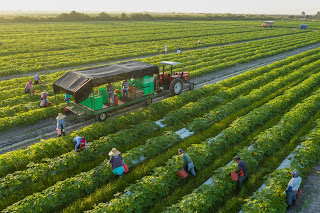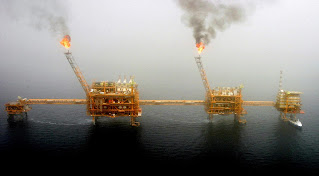Food, electricity and water: that's what the UN calls the
'nexus' of sustainable growth. As the world's population has increased and
become wealthier, demand for all three has risen rapidly. Not only has demand
risen for all three, they are also closely interlinked: food production
requires water and energy; conventional energy production needs water
resources; agriculture offers a potential source of energy.
This article focuses on food's environmental effects.
Sustaining access to a nutritious diet by everyone in the world is one of the
biggest challenges we face. In various entries, we cover the human aspects of
food and nutrition, including hunger and undernourishment, micronutrient
deficiency, diet compositions and obesity.
Eco-impacts of food and agriculture
What are food and agriculture's environmental impacts
The visualization shows a summary of some major global
impacts:
Half of the world's (ice- and desert-free) agricultural land
is used;
Agriculture uses 70 % of global freshwater withdrawals
Agriculture accounts for 78% of global ocean and freshwater
eutrophication (nutrient-rich waterway pollution)
94% Livestock is mammal biomass (excluding humans). This
means that livestock outweigh wild mammals by a factor of 15-to-1.4 of the
28,000 species assessed as endangered on the IUCN Red List, agriculture and
aquaculture are listed as a threat to 24,000 of them.
Food therefore lies at the root of trying to tackle climate
change, reduce water stress, pollute, restore land to forests or grasslands,
and protect the world's biodiversity.
Half of the world's land used for agriculture
Much of the world's land was wilderness for most of human
history: trees, grasslands and shrubbery dominated its ecosystems. This has
changed drastically in recent centuries: wild ecosystems have been squeezed out
by transforming it into agricultural land.
If we rewind 1000 years, it is estimated that just 4 million
square kilometers – less than 4% of the world's ice-free and barren land area
has been used for farming.
In visualization we see today's breakdown of global land
area. 10% of the world is covered by glaciers and 19% is barren land – deserts,
dry salt flats, beaches, sand dunes and exposed rocks.6 This leaves what we
call 'habitable land.' Agriculture uses half of all habitable land.
This leaves just 37% for forests; 11% as shrubs and
grasslands; 1% as freshwater cover; and the remaining 1% – much less than other
suspects – is made up urban area that includes cities , towns, villages, roads,
and other human infrastructure.
There is also a highly unequal distribution of land use
between livestock and human crops. If we combine pastures used for grazing with
land used to grow animal feed crops, livestock accounts for 77% of global
farming land. Though livestock occupies much of the world's agricultural land,
it only produces 18% of the world's calories and 37% of total protein.
Agricultural growth was one of the greatest environmental
effects of mankind. It has changed ecosystems and is one of the biggest
biodiversity pressures: of the 28,000 species listed as endangered on the IUCN
Red List, agriculture is listed as a threat to 24,000 of them.9 But we also
know that we can reduce these impacts – both through dietary changes, by
replacing some meat with plant-based alternatives, and by advancing technology.
In recent decades, crop yields have increased dramatically, meaning we have
saved a lot of land from agricultural production: globally, to grow the same
amount of crops as in 1961, we only need 30% of the farmland.
With consumer and producer solutions, we have an important
opportunity to restore some of this farmland back to forests and natural
habitats.
With customer and producer approaches, we have a big
opportunity to return some of this farmland back to forests and ecosystems.
Land-use food footprint
How do different food items equate land footprint? Which
foods used most and least land in production?
These comparisons are based on mass: the land used to
generate one kilogram of food.
However, it is often important to look at these contrasts in
terms of nutritional units: this provides a measure of how low or high-impact
various foods provide protein or energy / calories.
In the visualizations here we demonstrate the land footprint
of foods, measured in square meters (m2) per kilogram, 100 grams of protein,
and 1000 kilocalories. These charts are interactive and can be added and
removed using the 'add food' icon.
Food output accounts for one-quarter of global greenhouse gas emissions
When addressing climate change, the emphasis appears to be
on 'clean energy' options – implementing renewable or nuclear energy; enhancing
energy efficiency; or transitioning to low-carbon transport. Nevertheless,
biomass, whether in power, heat, transportation or industrial processes,
accounts for the majority – 76% – of greenhouse gas ( GHG ) emissions.
Yet the global food system, which involves production and
post-farm processes such as refining and distribution, also leads to pollution.
And it’s a problem for which we don’t yet have viable technological solutions.
Yet the global food system, which involves production and
post-farm processes such as refining and distribution, also leads to pollution.
And it's a problem we don't have viable technological solutions yet.
Feed accounts for about 26% of global GHG emissions.
There are four main factors to remember when quantifying
food emissions. These are shown by visualization category:
Livestock & fisheries represent 31% of food emissions.
Livestock – animals raised to produce meat , dairy, eggs and
seafood – contribute to emissions in several ways. For example, ruminant
animals—mostly cattle—produce methane through their digestive processes (in a
process known as 'enteric fermentation').
Manure management, farm management, and fishing vessel fuel
use also fall into this group. This 31% of emissions only concern on-farm
'output' pollution: it does not include land use change or supply chain
pollution from animal feed crop processing: these statistics are listed
separately in other categories.
Farming accounts for 27% of food pollution.
21% of food emissions come from crop production for direct
human consumption, and 6% from animal feed production. These are the direct
emissions arising from agricultural activity – which involves factors such as
releasing nitrous oxide from fertilizer and manure application; rice methane
emissions; and farm machinery carbon dioxide.
Land usage accounts for 24% of food pollution.
Twice as many emissions result from land use for livestock
(16 percent) as crops for human use (8 percent). Agricultural growth results in
the conversion of trees, grasslands and other carbon 'sinks' into croplands or
pastures resulting in carbon dioxide emissions. 'Land use' is a total of land
use transition, savannah burning, and organic soil agriculture (plowing and
soil overturning).
Supply chains contain 18% of food emissions.
Food processing (converting farms into finished products),
transport , packaging and retail all require energy and resource inputs. Many
believe that eating local is essential to a low-carbon diet, but transport
emissions are only a very small percentage of overall food emissions — only 6
percent globally.
Reducing food pollution will be one of our biggest
challenges in the coming decades. Unlike other areas of energy production where
viable prospects for upgrading low-carbon energy – renewable or nuclear – are
visible, the ways of decarbonizing agriculture are less evident. We need inputs
like fertilizers to meet rising food demands, and we can't avoid cattle
producing methane. We will need a range of solutions: dietary changes; food
waste reduction; agricultural production improvements; and low-carbon food
alternatives are scalable and affordable.





Comments
Post a Comment